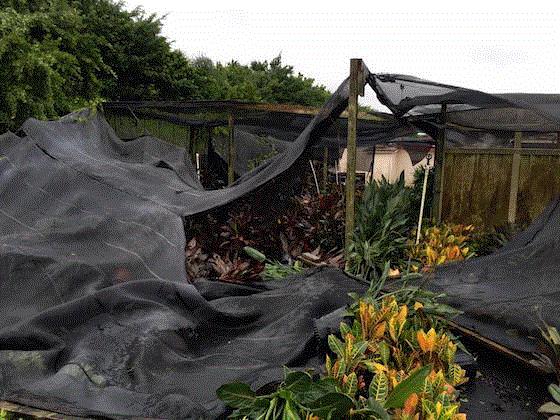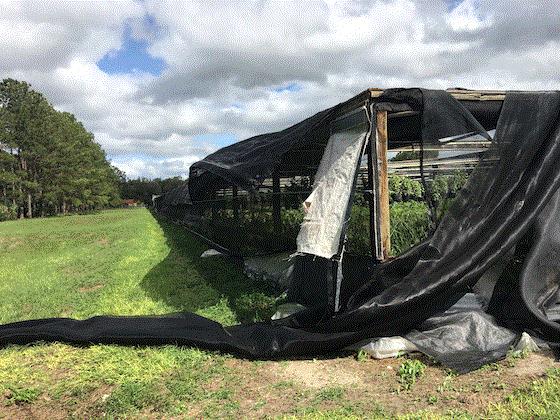Irma’s Impact …
The last time you heard from me we were all anxiously awaiting Hurricane Irma. Now with more than a full week of clean-up activities under Florida’s belt, we can look back and assess.
In a nutshell, Irma was a doozy. But the storm’s impact could have been far, far worse. Maybe it was better forecasting. Maybe it was the scare of and lessons learned from Hurricane Harvey. Or maybe it was the memory of Hurricane Andrew that prompted folks in the horticulture industry to prepare as best they could. In the end, many lost some, and some lost it all.

A photo of a destroyed shade nursery shared on FNGLA's website.
At the end of last week, FNGLA’s Ben Bolusky sent out a special edition of Ben’s Bullets, in which he listed Irma’s estimated impact on Florida’s horticultural industry. If you don’t receive that e-newsletter, here are a few key points:
-
Damage and loss of plant/tree inventory varies wildly across the state. Some businesses are flooded and others sustained wind damage.
-
A lack of power and fuel to run generators and irrigation systems directly after the storm resulted in some nursery crop losses. These lost sales after the storm are made worse by lost sales preceding the storm (due to storm prep, shipping stoppage, etc.).
-
Most nurseries experienced some structural damage, and some experienced substantial damage of shade and plastic. Some even suffered collapsed production facilities.
… And Recovery
FNGLA created a website where you can ask for or offer assistance. You can find that resource at www.fngla.org/irma. It’s storms like Irma—both within the horticulture industry and as a community, in general—that really bring out the best of folks, and it’s really something to see.

FNGLA had already spoken to Adam Putnam, Florida’s Commissioner of Agriculture and Consumer Services, last week. Among the issues FNGLA asked the Commissioner to urgently address are those dealing with generator fuel, debris cleanup assistance and disposal/recycling of plastics and the landfill rules and tonnage fees associated with that.
Stay tuned to the weekly Ben’s Bullets and our biweekly Tropical Topics for updates on Florida’s recovery and aftermath issues that arise—and are successfully addressed!
“Weathered the Storm”
Pieter Mertens toured me through the Deroose Plants glass greenhouse in Apopka back in May 2016, and so I wondered how that structure fared during Irma. “We weathered the storm fairly well,” Peiter responded via email. The glass greenhouse “withstood the tempest like a champ,” he said. Only two broken windows! They were in much better condition than home down the street which, as we communicated, was being swallowed by a sinkhole (which, ironically, I saw footage of on last night’s evening news).
For the first time since the greenhouse was built in 2001, they had water in their overflow pond, to give you some idea of how much water they had. They had some downed trees on the property but not on the greenhouse. Deroose prepped for the storm by closing the shade curtains and irrigating the crops, just in case the power went out—which it did, but they were on generator power for just a day. They got full power back yesterday.
Their shade houses on another property didn’t fair as well—toppled plants, damage to the roofs, debris, etc. They had all hands on deck to pull and staple the shade cloth before they could get sunburned. Right now the biggest losses will be a result of the plants being “roughed up.”

Indirect impact, Pieter explained, is really coordinating postponed or cancelled shipments from customers in South Florida. Speed of recovery is different for different operations, and he says it’ll likely be a couple more weeks until everything is “back to business as usual.”
“Open for Business”
I spoke with Austin Bryant of Heart of Florida Greenhouses in Zolfo Springs just this morning. Highlands County had Irma’s eyewall pass right over. Unfortunately they didn’t get to experience the actual calm center of the eye—just the brutal winds and “dancing tornados” that exist in that dangerous wall.
Despite these “dancing tornados” that pop down from the clouds every now and again to wreck havoc, Heart of Florida is open for business. He wants folks to know that although there was great destruction wrought by Irma—he estimates they lost 3.5 to 4 acres—there’s plenty of good news, too. “Even when the shade structure itself is uplifted and ripped off, many times the plants themselves are simply laid over.” Austin says interior foliage growers like themselves typically have 2.5 days to get out there, pick up the salvageable plants (and many are still perfect!) and find an undamaged or quickly repaired shade structure—the cloud cover stays for a bit before the sun comes out like nothing ever happened. “You go in, pick and choose what’s most important to get out. You try your best to get plants of all ages … so that even though your availability may be small, hopefully it’ll be consistent over the next several months as we rebuild.”

A panoramic view of Heart of Florida shade houses. The complete flattening on the right is indicitive of tornado damage.
The irrigation systems are often ripped up along with that shade structure, and even though it may have rained tons and the ground is still wet, those exposed pots can hold only so much water before that sun starts to dry them out. Austin says the days following a hurricane are a constant cycle of moving plants around, repairing shade structures and hacking together irrigation lines. “At times it feels like you’re a civil war surgeon,” he said, “we cut and cauterize, this goes there, and we’re saving this.”
It’s a learning experience, Austin points out. Going around to all the structures to see what held and what didn’t, they can then apply that information when they get to constructing new and repaired structures. But he says they have about six weeks of repair before they absolutely must put up poly for winter frost protection.
“Your biggest goal after a disaster like this is to get the word out that you are okay and that business is going to continue,” he says. He’s thankful so many customers have reached out to them with concern. The best thing folks can do to help? Order plants! Some business in Florida has the plants you need, it’s just finding who has it. “People here, we took a licking,” he says, “but there are plants here, and the more plants we can sell today, the fewer plants I have to hold until tomorrow in a structure that could be compromised, and it also frees up space for me to put more plant material in. It helps us so much.”
“Better Than I Had Hoped”
I checked in with Terri Bates of Bates Sons & Daughters in Lake Placid, also in Highlands County. As for damage, there’s “nothing that can’t be fixed or replaced,” she said. “The caladium fields got about 12 in. of rain and it took three days for the water to recede.” Despite winds of 105 to 115 mph, the caladiums “look better than I had hoped.” Terri’s “cautiously optimistic” about their own crop damage, which they estimate at around 20%-25%.
Yesterday was her first day back in the office, mainly to call and reassure her customers that they’ll do their very best to provide them with quality product for 2018. “It was such a pleasure to realize that most of them had already called or emailed us to make sure we were safe and everything was okay. I have been overwhelmed with the concerns and the numerous offers of help. It makes me realize why I love this industry.”
“More Stubborn Than Most”
You’ll recall my coverage of the fernery damage in Volusia County due to Hurricane Matthew last September. Well, the cut foliage industry was hit hard again by Irma.
Jana Register of the Fern Trust checked in with me to tell me the latest. She said early estimates put damage at about 70-75%. With more than a day of sustained hurricane winds, they again have structural damage to their shade cloth ferneries, and the many of the oak hammocks that provide shade to underlying fields were destroyed. “All crops suffered losses, which will dramatically impact supplies in the months to come.” They won’t know the full impact for a few weeks as crops begin to either recover or show signs of damage. It’s a waiting game. But they learned some lessons from Matthew and those are helping as the cut foliage industry starts its recovery.
Ag Commissioner Putnam will be at Fern Trust this afternoon to survey the damage and see firsthand how the industry is struggling. “Our industry lost a few growers last year and some other acreage was up for sale when Irma visited,” Jana said. “This second storm in less than a year has lots of growers rethinking the future. Thank goodness our grower members are more stubborn than most and are committed to rebuilding yet again.”
How’d the Botanic Gardens Fare?
Dr. Richard Criley has been watching the impact of Irma safely from Hawaii. But he’s concerned about the damage to the botanic gardens in South Florida—the Fairchild in Miami and the one in Naples he mentioned to me specifically.
If you belong to those institutions or any other botanic garden in Florida—or you know of their status—please check in with me! Drop me a line (and send photos) HERE.
Thanks for letting me in your inbox this week, folks. Much appreciated! Meanwhile, comments, questions, quandries? If so, just drop me a line at ewells@ballpublishing.com.

Ellen Wells
Editor-at-Large
Green Profit
This edition of Tropical Topics was sent to 26,185 loyal readers!
If you're interested in advertising on Tropical Topics contact Kim Brown ASAP!